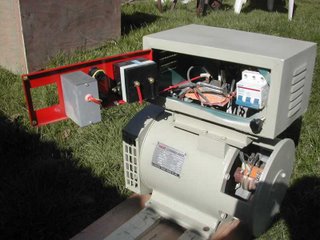

Tuesday started bright, sunny and frosty and at 8am I had picked up a Luton van from Leatherhead and was heading along the M25 at 15mph in the general direction of Southampton.
The prime reason for this mission was that 3 pallet loads of Chinese alternators had just arrived, and at least one of them had my name on it - metaphorically speaking.
The first task was to rendevue with Mark Walker of Volvox Engineering at the Fleet Services on the M3, as he had the necessary paperwork to release the consignment from the shipping agent's warehouse.
By 11am we had 18 large plywood cases in the back of the van and were northbound back up the M3 with a full load of 3kW, 5kW and 7.5kW alternators.
The photo shows the 3kW alternator alongside my 6hp Lister engine, ready to have the two shafts coupled together with a toothed belt and pulleys. An 80 tooth pulley on the engine will drive a 32 tooth pulley on the alternator, so when the engine is doing 600rpm, the alternator is turning at the necessary 1500rpm to make 50Hz mains electricity.
Before this can happen, I have to make a small alteration to the old Startomatic baseplate to allow it to take the new alternator on sliding rails, allowing the belt tension to be adjusted.
The alternators have an iron cored rotor, wound with an electromagnet field coil. Around the outside of the rotor are the 4 pole stator windings that produce the 230V ac.
When the engine spins the rotor up to speed, the residual magnetism retained in the soft iron core, causes a current to be generated in a special winding in the stator that is used to generate about 50 volts to excite the rotor. A rectifier turns this 50V ac into dc and feeds it back through slip rings into the rotor winding, strengthening the residual magnetism and producing more power.
The clever bit about these alternators is that they use an automatic voltage regulator (AVR) that controls the rotor field current and helps to keep the voltage output of the alternator within reasonably tight limits, even though the speed of the engine may change when you add or remove large electrical loads.
The second photo shows the "doghouse" on top ofthe alternator that contains the rectifier, AVR, voltmeter and a whole host of interesting Chinese style electrics, designed so that you can get both 230V and 115V from this alternator. You can also just see the sliprings on the end of the rotor shaft.
So we are close approaching the time that we will have vegetable oil power, produced from this very simple but very rugged home generator system.
Meanwhile the solar water panel has been earning its keep. There is hot water at 60 C coming from it at 9.00am on sunny mornings until 4 in the afternoon.
3 comments:
A newcomer writes.... all very interesting reading. I look forward to reading more.
Very interesting Ken, I'm looking for some kind of generator for a small hydroelectric power project. Sounds like this one might be an answer. Hugh Price
hi ken,
i am developing a wave power project and this type of alternator could be perfect for me. where did you get these from exactly and how much did the 3kw one cost?
cheers,
nick boyd
Post a Comment